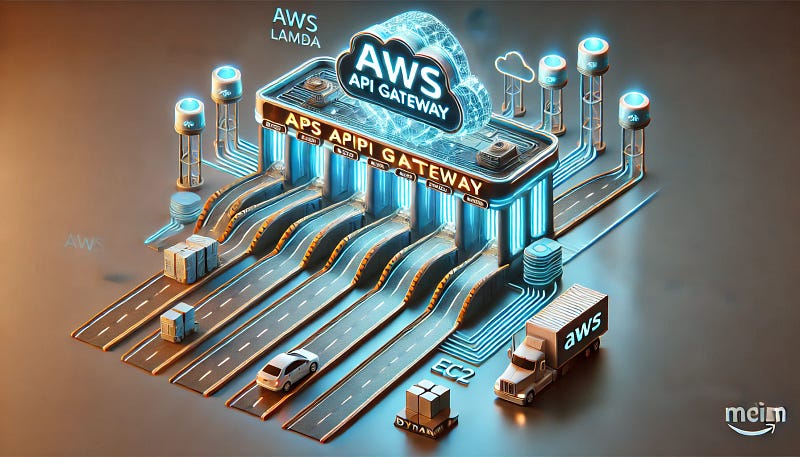AWS API Gateway: The Ultimate Traffic Controller 🚦for Your APIs
 Agilan Vageesan
Agilan Vageesan
🌉 API Gateway Explained: Think of It Like a Smart Toll Booth System!
Imagine a highway toll booth system 🚗. Each car (API request) must go through a toll booth (API Gateway) before reaching its destination (backend services). The toll booth ensures the right cars get through, charges fees, manages traffic flow, and applies security measures.
That’s AWS API Gateway! It acts as the entry point for all API traffic, ensuring efficient routing, security, monitoring, caching, and authentication before requests reach your backend services.
🌟 Key Features:
✅ Traffic Management — Controls API requests and applies rate limits 🚦
✅ Security & Authentication — Ensures only authorized access 🔐
✅ Performance Optimization — Caching for faster response times ⚡
✅ Monitoring & Logging — Tracks API activity in real time 📊
✅ Flexible Deployment — Supports REST, HTTP, and WebSocket APIs 🌍
🛠️ How API Gateway Works: Step-by-Step
1️⃣ API Request Sent — A user (or system) sends an API request via HTTP/S.
2️⃣ API Gateway Processes the Request — Validates, secures, and transforms the request.
3️⃣ Integration with Backend — Forwards the request to AWS Lambda, EC2, or other backend services.
4️⃣ Response Sent Back — The processed data is returned to the client.
📌 Think of it as a smart traffic controller, ensuring every request gets where it needs to go efficiently!
🚦 Managing API Versions with Stages & Deployments
API Gateway allows you to manage multiple versions of your API using stages (e.g., dev, staging, prod).
🔹 Stages — Different environments for testing and production.
🔹 Deployment — Rolling out new versions safely.
🔹 Canary Deployments — Gradually shifting traffic to a new API version without downtime. 🐤
📌 Think of this like adding new toll booths to the highway without blocking traffic!
🔄 API Gateway Integration Types: Connecting Your Backend
API Gateway connects to various AWS services & external endpoints:
✅ Lambda Proxy Integration — Serverless API execution ⚡
✅ HTTP Integration — Connects to external HTTP endpoints 🌐
✅ AWS Service Integration — Directly interacts with AWS services (S3, DynamoDB) 🔄
✅ Mock Integration — Returns static responses for testing 📦
📌 Each integration type defines how requests are processed and routed!
📝 Transforming API Requests with Mapping Templates & OpenAPI
🔹 Mapping Templates — Transform API requests & responses using Velocity Template Language (VTL).
🔹 OpenAPI Support — Define API structures using the OpenAPI standard for better documentation.
📌 Think of this as a translator at the toll booth, converting different request formats into a common language!
⚡ Performance Optimization: Boost API Speed with Caching
Instead of processing the same request repeatedly, API Gateway caching stores responses temporarily for quick access.
✅ Faster Response Times — Avoids repetitive processing.
✅ Lower Backend Load — Reduces API calls to services like Lambda & DynamoDB.
✅ Cost Savings — Fewer requests = lower API costs.
📌 Think of caching like an express toll lane — frequent travelers don’t need to stop every time!
🔑 Security & Access Control: Protecting Your APIs
API Gateway ensures only authorized users access your APIs through:
🛡️ Authentication & Authorization
✅ IAM Authentication — Restricts access to AWS users.
✅ Cognito Authentication — Manages users via AWS Cognito.
✅ Lambda Authorizers — Custom authentication logic using AWS Lambda.
✅ API Keys & Usage Plans — Rate limiting for API consumers.
✅ CORS (Cross-Origin Resource Sharing) — Allows safe cross-domain API requests. 🌍
📌 Think of this like toll passes — only authorized cars can use express lanes!
📡 Monitoring & Debugging: Tracking API Performance
API Gateway integrates with:
✅ CloudWatch Metrics & Logs — Track API performance & errors.
✅ X-Ray Tracing — Debug API request flows.
✅ Access Logs — Monitor who is calling your API and from where.
📌 Think of this as highway surveillance cameras monitoring traffic conditions!
🏗️ API Gateway Architecture: Different API Models
✅ Edge-optimized APIs — Globally distributed APIs with AWS CloudFront.
✅ Regional APIs — APIs within a specific AWS region for lower latency.
✅ Private APIs — Secure APIs accessible only within a VPC.
📌 Think of these as different types of toll roads — some local, some global, some restricted!
🎯 Conclusion: API Gateway is the Backbone of Modern APIs!
AWS API Gateway is like a highly efficient toll booth system, managing traffic, security, caching, and authentication for your APIs. Whether you’re building serverless applications, real-time APIs, or microservices, API Gateway is a must-have tool! 🚀
💡 How do you use API Gateway in your projects? Let’s discuss in the comments! 👇
Subscribe to my newsletter
Read articles from Agilan Vageesan directly inside your inbox. Subscribe to the newsletter, and don't miss out.
Written by
